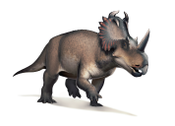犹他角龙属
| 犹他角龙属 化石时期:白垩纪晚期,
| |
|---|---|

| |
| 重建骨架模型,位于犹他自然史博物馆 | |
| 科学分类 | |
| 界: | 动物界 Animalia |
| 门: | 脊索动物门 Chordata |
| 纲: | 蜥形纲 Sauropsida |
| 总目: | 恐龙总目 Dinosauria |
| 目: | †鸟臀目 Ornithischia |
| 科: | †角龙科 Ceratopsidae |
| 亚科: | †开角龙亚科 Chasmosaurinae |
| 属: | †犹他角龙属 Utahceratops Sampson et al., 2010 |
| 模式种 | |
| †葛氏犹他角龙 Utahceratops gettyi Sampson et al., 2010
| |
犹他角龙属(属名:Utahceratops,意为“犹他的有角面孔”)是一属角龙科恐龙,生存于白垩纪晚期(约7640万至7550万年前)的美国犹他州。犹他角龙是大型、健壮、陆生、四足草食性动物,体型可生长至约7米长。
发现[编辑]
属名意指“犹他的有角面孔”,由犹他(Utah)及古希腊文的keras∕κέρας(角)和ops∕ὤψ(脸)组成。[1]种名gettyi纪念正模标本的发现者及在大升梯国家纪念区化石挖掘活动的主要贡献者Mike Getty。最早于2010年由史考特·D·山普森、马克·A·洛温、安德鲁·A·法克、艾瑞克·M·罗伯茨、凯瑟琳·A·福斯特、约书亚·A·史密斯、亚伦·L·泰特斯正式命名,模式种为葛氏犹他角龙(Utahceratops gettyi)。[2]
叙述[编辑]

正模标本编号UMNH VP 16784只包含一个部分头骨。本属所知来自六具标本,其中包括两个部分头骨,将这些标本组合在一起共保存了90%的头骨及70%的颅后骨骼。犹他角龙估计有2米高、约6至7米长、及3至4吨重。[3]
根据山普森等人(2010),犹他角龙的鉴定特征包含:鼻角位于末端,几乎完全位于外鼻孔之后;眉角短而粗壮、朝向背外侧、形状圆扁而尖端钝;褶饰横向中位的外鳞状骨低矮并大幅加长(有些长于10公分);顶骨中位转弯处呈弧形弯曲。[2]
系统发生学[编辑]



犹他角龙被分类至角龙科的开角龙亚科,并发现与五角龙一同位于开角龙亚科的基础演化位置。[2]
以下演化树取自隆里曲(2014)命名五角龙新种的研究,包含了几乎所有开角龙亚科物种:[4]
| 开角龙亚科 Chasmosaurinae |
| |||||||||||||||||||||||||||||||||||||||||||||||||||||||||||||||||||||||||||||||||||||||||||||||||||||||||||||||||||||||||||||||||
古生态学[编辑]
栖地[编辑]

犹他角龙的唯一物种来自犹他州的凯帕罗韦兹组,[2]根据氩氩测年法鉴定出沉积年代为7660万至7450万年前的坎潘阶。[5][6]在白垩纪晚期凯帕罗韦兹组位于西部内陆海道西岸的拉腊米迪亚,当时的恐龙栖地是个古老的泛滥平原,由大河道、丰富的湿地泥炭沼泽、池塘和湖泊所主宰,并与高原接壤。气候潮湿并支持着高多样性生物群。[7]此地层保存了世界上最完好、最连续性的白垩纪晚期陆相生物群之一。[8]
古生物种[编辑]
犹他角龙与其他物种共享栖地:奔龙科、伤齿龙科的塔罗斯龙、暴龙科的怪猎龙、甲龙类、鸭嘴龙科的短冠副栉龙、纪念区格里芬龙、角龙科的大鼻角龙、华丽角龙、偷蛋龙类的哈格里芬龙、[9]可能还有似鸟龙科的似鸟龙、暴龙科的亚伯托龙、鲨和𫚉、青蛙、蝾螈、乌龟、蜥蜴、鳄鱼、各种早期哺乳类如多瘤齿兽目、有袋类和食虫目。[10]
延伸阅读[编辑]
参考资料[编辑]
- ^ Liddell, Henry George and Robert Scott. A Greek-English Lexicon (Abridged Edition). United Kingdom: Oxford University Press. 1980. ISBN 0-19-910207-4.
- ^ 2.0 2.1 2.2 2.3 Sampson, S. D.; Loewen, M. A.; Farke, A. A.; Roberts, E. M.; Forster, C. A.; Smith, J. A.; Titus, A. L. Stepanova, Anna , 编. New Horned Dinosaurs from Utah Provide Evidence for Intracontinental Dinosaur Endemism. PLoS ONE. 2010, 5 (9): e12292. PMC 2929175
 . PMID 20877459. doi:10.1371/journal.pone.0012292.
. PMID 20877459. doi:10.1371/journal.pone.0012292.
- ^ Descubren nuevos dinosaurios con cuernos [New dinosaurs with horns have been discovered]. La Nación. 26 September 2010 [22 December 2014]. (原始内容存档于12 June 2013) (西班牙语).
- ^ Longrich, N. R. The horned dinosaurs Pentaceratops and Kosmoceratops from the upper Campanian of Alberta and implications for dinosaur biogeography. Cretaceous Research. 2014, 51: 292. doi:10.1016/j.cretres.2014.06.011.
- ^ Roberts EM, Deino AL, Chan MA (2005) 40Ar/39Ar age of the Kaiparowits Formation, southern Utah, and correlation of contemporaneous Campanian strata and vertebrate faunas along the margin of the Western Interior Basin. Cretaceous Res 26: 307–318.
- ^ Eaton, J.G., 2002. Multituberculate mammals from the Wahweap(Campanian, Aquilan) and Kaiparowits (Campanian, Judithian) formations, within and near Grand Staircase-Escalante NationalMonument, southern Utah. Miscellaneous Publication 02-4, UtahGeological Survey, 66 pp.
- ^ Titus, Alan L. and Mark A. Loewen (editors). At the Top of the Grand Staircase: The Late Cretaceous of Southern Utah. 2013. Indiana University Press. Hardbound: 634 pp.
- ^ Clinton, William. Preisdential Proclamation: Establishment of the Grand Staircase-Escalante National Monument. September 18, 1996. [9 November 2013]. (原始内容存档于28 August 2013).
- ^ Zanno, Lindsay E.; Sampson, Scott D. A new oviraptorosaur (Theropoda; Maniraptora) from the Late Cretaceous (Campanian) of Utah. Journal of Vertebrate Paleontology. 2005, 25 (4): 897–904. doi:10.1671/0272-4634(2005)025[0897:ANOTMF]2.0.CO;2.
- ^ Eaton, Jeffrey G.; Cifelli, Richard L.; Hutchinson, J. Howard; Kirkland, James I.; Parrish, J. Michael tyrannosaurid albertosarus. Cretaceous vertebrate faunas from the Kaiparowits Plateau, south-central Utah. Gillete, David D. (编). Vertebrate Paleontology in Utah. Miscellaneous Publication 99-1. Salt Lake City: Utah Geological Survey. 1999: 345–353. ISBN 1-55791-634-9.
| |||||||||||||||||||||||||||||||||||||||||||||||||||||||||||||||||||||||||||||||||||||||||||||||||||||||||||||||||||||||||||||||||||||||||||||||||||||||||||||||||||||||||||||||||||||||||||||||||||||||||||||||
|




